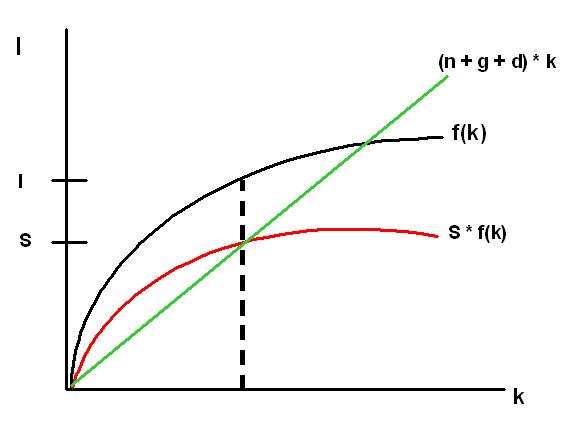2.1 Harrod–Domar model
The Harrod–Domar
model is a Keynesian model of economic
growth. It is used in development economics to explain an
economy's growth rate in terms of the level of saving and of capital. It suggests that there is no natural
reason for an economy to have balanced growth. The model was developed
independently by Roy F. Harrod in 1939,
and Evsey Domar in
1946, although a similar model had been proposed by Gustav Cassel in
1924. The Harrod–Domar model was the precursor to the exogenous growth model.
Neoclassical economists claimed
shortcomings in the Harrod–Domar model—in particular the instability of
its solution—and, by the late 1950s, started an academic dialogue that led to
the development of the Solow–Swan model.
According to the Harrod–Domar model, there are three
kinds of growth: warranted growth, actual growth and the natural rate of growth.
The warranted growth rate is the rate of growth at
which the economy does not expand indefinitely or go into recession. Actual
growth is the real rate increase in a country's GDP per year. (See also: Gross domestic product and Natural gross domestic product).
Natural growth is the growth an economy requires to maintain full employment.
For example, If the labour force grows at 3% per year, then to maintain
full employment, the economy’s annual growth rate must be 3%.
Although the Harrod–Domar model was initially created
to help analyse the business cycle, it was later adapted to explain
economic growth. Its implications were that growth depends on the quantity of
labour and capital; more investment leads to capital accumulation, which
generates economic growth. The model carries implications for less economically developed countries,
where labour is in plentiful supply in these countries but physical
capital is not, slowing down economic progress. LDCs do not have sufficiently high
incomes to enable sufficient rates of saving; therefore, accumulation of
physical-capital stock through investment is low.
The
model implies that economic growth depends on policies to increase investment,
by increasing saving and using that investment more efficiently through
technological advances.
The
model concludes that an economy does not "naturally" find full
employment and stable growth rates.
2.3 Karl Marx Theory of Development
Karl
Marx, the father of scientific socialism, is considered a great thinker of
history.
He is
held in high esteem and is respected as a real prophet by the millions of
people.
Prof.
Schumpeter wrote,
“Marxism is a religion. To an orthodox Marxist, an opponent is not merely
in error but in sin”.
He is
regarded as the father of history who prophesied the decline of capitalism and
the advent of socialism.
The
Marxian analysis is the greatest and the most penetrating examination of the
process of economic development. He expected capitalistic change to break down
because of sociological reasons and not due to economic stagnation and only
after a very high degree of development is attained. His famous book ‘Das
Kapital’ is known as the Bible of socialism (1867). He presented the process of
growth and collapse of the capitalist economy.
Assumptions of the
Theory:
Marxian economic
theory of growth is based on certain assumptions:
1.
There are two principal classes in society. (1) Bourgeoisie and (2) Proletariat.
2.
Wages of the workers are determined at a subsistence level of living.
3.
Labour theory of value holds good. Thus labour is the main source of value
generation.
4.
Factors of production are owned by the capitalists.
5.
Capital is of two types: constant capital and variable capital.
6.
Capitalists exploit the workers.
7.
Labour is homogenous and perfectly mobile.
8.
Perfect competition in the economy.
9.
National income is distributed in terms of wages and profits.
Marxian Concept of
Economic Development:
In
Marxian theory, production means the generation of value. Thus economic
development is the process of more value-generating, labour generates value.
But a high level of production is possible through more and more capital
accumulation and technological improvement.
At the
start, growth under capitalism, generation of value and accumulation of capital
underwent at a high rate. After reaching its peak, there is a concentration of capital
associated with the falling rate of profit. In turn, it reduces the rate of
investment and as such a rate of economic growth. Unemployment increases. Class
conflicts increase. Labour conflicts start and there are class revolts.
Ultimately, there is a downfall of capitalism and the rise of socialism.
Video
Lecture Links:

Comments
Post a Comment